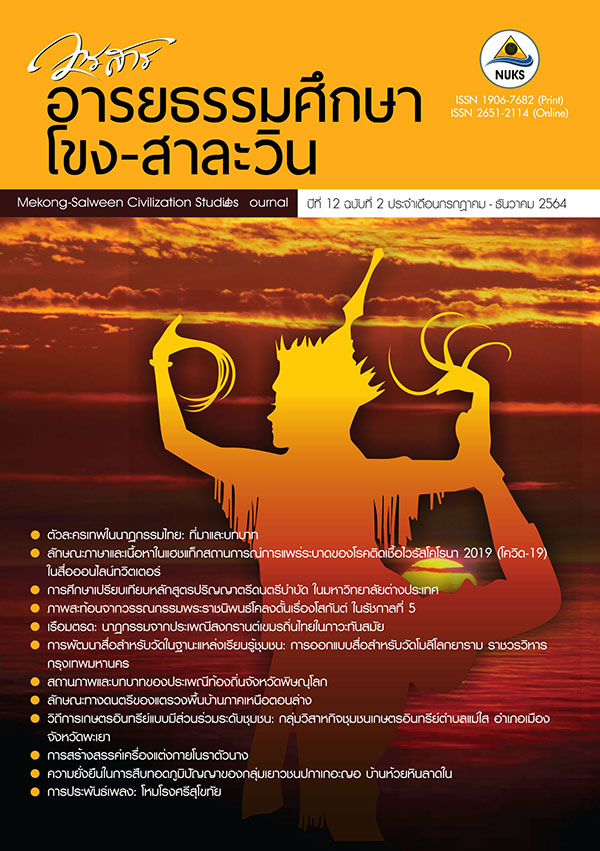Reflection of Events The Reflection in King Rama V’s Poem "Sokanta" ภาพสะท้อนจากวรรณกรรมพระราชนิพนธ์โคลงดั้นเรื่องโสกันต์ ในรัชกาลที่ 5
Main Article Content
Abstract
This article aimed to present the reflections that appeared in the poem "Sokanta" in the reign of King Rama V which was part of the research titled "An Analysis of Poem ‘Sokanta’ composed by King Rama V” by using the documentary research process to present the major findings of the research. It was found that the royal ceremony ‘Sokanta’ or shaving the topknot was considered very important among the royal family members with the title ‘His/Her Royal Highness’ and higher during the period of popular tradition of Thai children wearing a topknot. ‘Sokanta’ could optionally be organized as a part of another royal ceremony called “Sampatcharachin” or organized separately according to the King’s demand. The detailed steps and crucial events of ‘Sokanta’ were evident in ‘Sokanta’ poem, composed by King Rama V at the age of only 19. Also, the findings revealed some reflections, such as the royal children undergoing the topknot shaving processes, schedules of events, ceremonial procedure, costume, processions, female soldiers called “Jingjo, or kangaroo,” a Siam flag in the reign of King Rama V, and Schneider cannons. The royal ceremony ‘Sokanta’ is thus deemed a valuable asset for current generations to appreciate although this ceremony no longer exists.
Downloads
Article Details
References
Anonymous Guru. (2002). Thai Military in Ancient Times. Retrieved September 29, 2005, from http://www.geocities.com/direk77/DL/Dcument/Reform02.html.
Chalachol, S. (n.d.). Evolution of Hairstyles in Thai History. Retrieved September 3, 2008, from http://www.artgazine.com/shoutouts/viewtopic.php?t=8107&start=0&postdays=0 &postorder=asc&highlight=&sid=d305fee18c42c4a8915c6f1d504626c7.
Chanthawit, N. (1999). Poom Textile. In Thai Cultural Encyclopedia, Central Region. (Volume 8). Bangkok: Thai Cultural Encyclopedia Foundation, Siam Commercial Bank.
Chulalongkorn, His Majesty King. (1970). The Royal Twelve-Month Ceremonies. 11th ed. Bangkok: Bannakarn.
Chulalongkorn, His Majesty King. (1995). Sokanta Royal Ceremony. Bangkok: Rungsilp Printing.
Damrong Rachanupap, Somdej Krom Phraya. (2003). Memories. Bangkok: Matichon.
Kasetsiri, C. (2004). The Reign of King Rama V and his Visit to India in 1871 and his Understanding of Reformation of the Reign. Art & Culture Magazine. 25(7), 153-160.
Khunchaykularbkhaw. (n.d.). King Rama V's Royal Visit to India. Retrieved October 7, 2005, from http://my.dek-d.com/dek-d/story/viewlongc.php?id=๒๑๖๗๙&chapter=๔.
Ministry of Interior. (1992). 100 Years of the Interior. Bangkok: Siri Wattana Printing.
National Identity Enhancement Office. (2005). The Important Flag of the Nation. Bangkok: National
Identity Board, Prime Minister's Office.
Navikcheevin, N. (1975). Sokanta Royal Ceremony. Bangkok: Religious Printing House.
Nitayasuwan, P. (1999). Rabeng. In Thai Cultural Encyclopedia, Central Region. (Volume 12). Bangkok: Thai Cultural Encyclopedia Foundation, Siam Commercial Bank.
Phayakaranon, Ch. (1999). Jingjo: Female Soldier. In Thai Cultural Encyclopedia, Central Region. (Volume 3). Bangkok: Thai Cultural Encyclopedia Foundation, Siam Commercial Bank.
Plai Noi, S. (1998). Hundreds of Anecdotes, Volume 1. Bangkok: Dok Ya.
Pramoj, Kh, M.R. (2001). Four Reigns. 12th ed. Bangkok: Dok Ya 2000.
Royal Institute. (2013). The Royal Institute's Dictionary, 2011. 2nd ed . Bangkok: Nanmee Books.
Savanayana, N. (1998). The Tradition of Keeping a Pacifier and Shaving of a Thai Child. Bangkok: Literature and History Division, Fine Arts Department.
Siwasriyanon, W. (1975). Literature and Literature Criticism. 5th ed. Bangkok: Phrae Pittaya.
Srikanok, B. (2007). Sokanta Royal Ceremony. In Encyclopedia of Thai Literature. (Volume 1). Bangkok: Nanmee Books.


